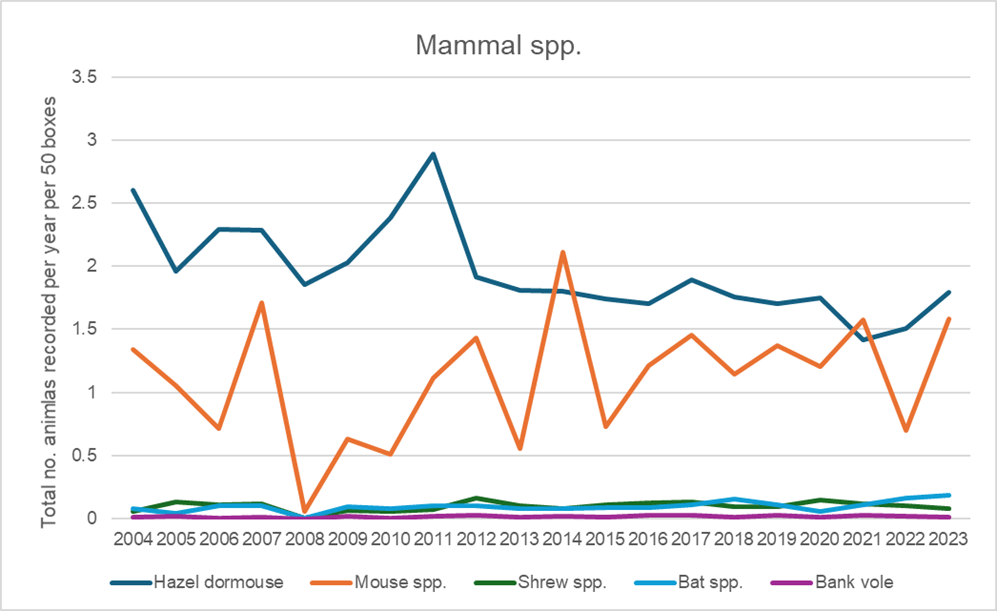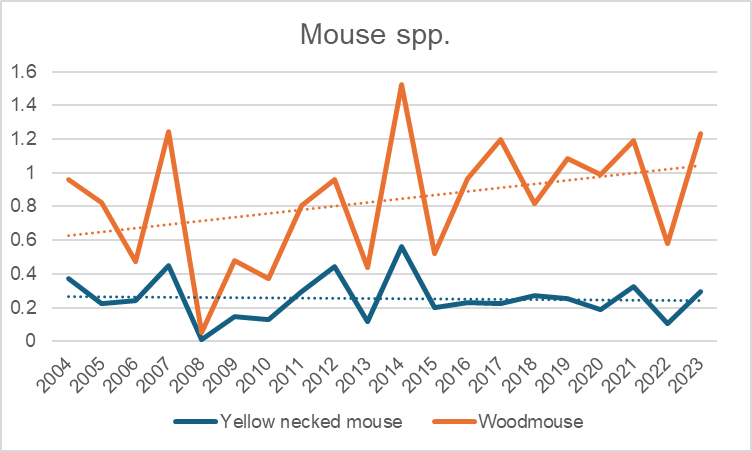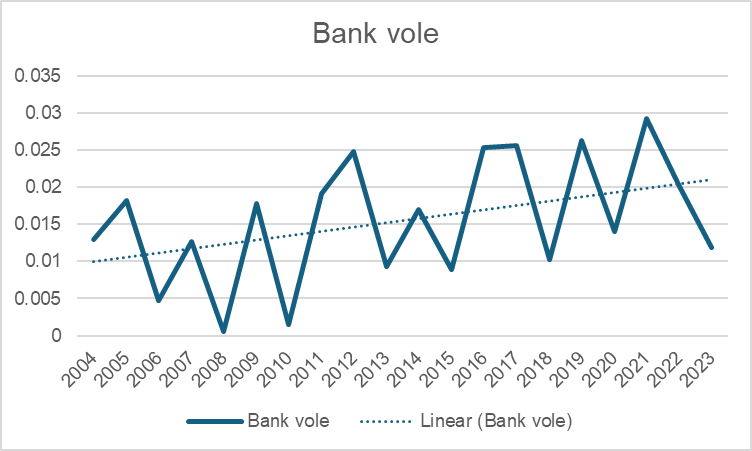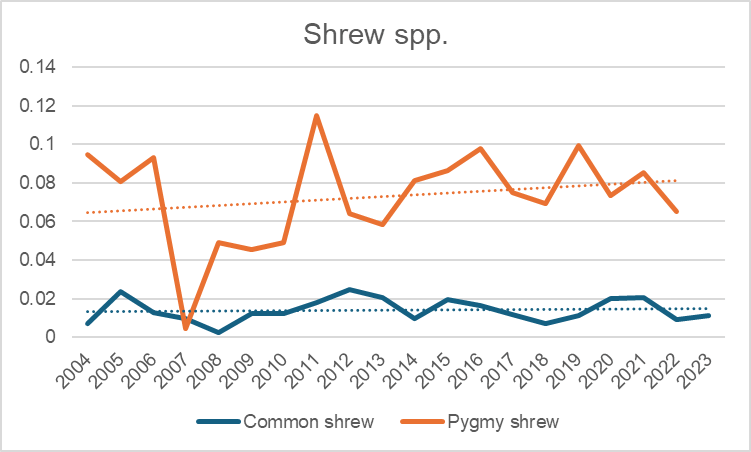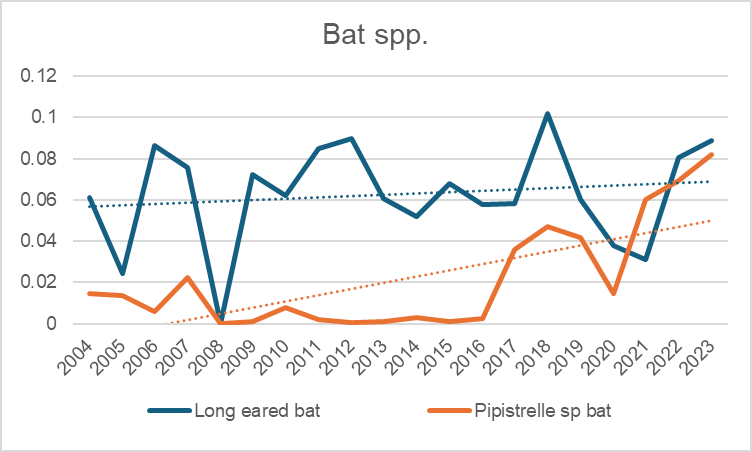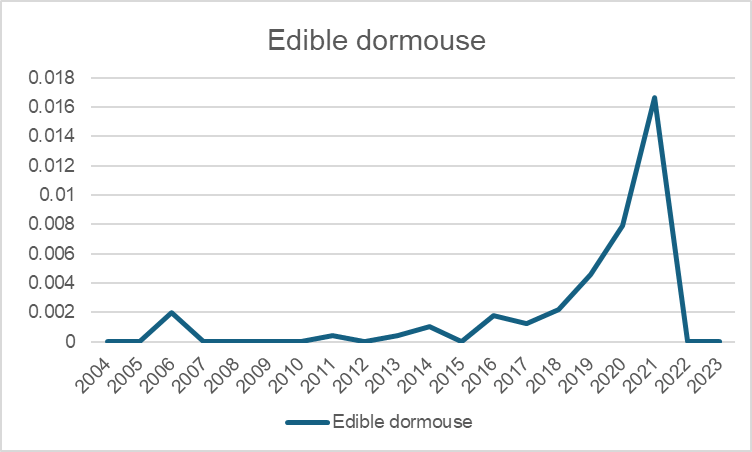The National Dormouse Monitoring Programme (NDMP) primarily focuses on tracking the population of hazel dormice and gathering essential biometric data on this endangered species to assess the health of Britain’s dormouse population. However, dormouse nest boxes are often utilised by other wildlife.
Over the past 20 years, we’ve regularly asked dormouse monitors to record any other mammals found in the boxes. So, what have we found…?
Bird boxes?
Birds are the most frequent non-dormouse occupants of the nest boxes, with species like blue tits and great tits commonly observed in spring. While there was interest in sharing bird data with the British Trust for Ornithology (BTO), the monthly survey frequency of the NDMP did not align with their Nest Recording Scheme standards.
To reduce bird occupancy in dormouse boxes, various nest box designs have been explored. The Brampton box, developed by the Bedfordshire, Cambridgeshire, and Northamptonshire Wildlife Trust, effectively excludes birds but is more complex to construct. The Nottinghamshire Dormouse Group has experimented with adjusting the access hole’s size and shape, with some success. However, it remains unclear if excluding birds improves dormouse nesting success. A study on the Isle of Wight showed that dormice often incorporate bird nests into their own, suggesting that exclusion may even reduce dormouse nesting opportunities.
Methodology
To compare nest box use across different species, we calculated the total number of animals recorded annually and the number of boxes checked each year. These data were standardised to show the number of animals found per 50 boxes checked annually. Despite bird use of some boxes, nest boxes appear to be serving their primary purpose for dormouse nesting (Figure 1). However, as dormouse records continue to decline, other small mammals may increasingly occupy the boxes.
Who’s at home? Frequent occupants
Wood mice and yellow-necked mice
Wood mice are the most common mammals recorded in the boxes apart from dormice. Yellow-necked mice are found in smaller numbers, with a Mammal Society report indicating wood mice are up to four times more common in areas where the two species overlap. Misidentification may contribute to discrepancies, as monitors may often record mice as wood mice without verifying if they’re yellow-necked mice. Both species appear to be stable or increasing in numbers based on NDMP records.
Bank voles
Bank voles are frequently recorded, and their numbers exhibit cyclical patterns. There’s also been a gradual increase in their records over time.
Shrews
Shrews, particularly pygmy shrews, are often found in nest boxes. For these small mammals, the safety of nest boxes, away from predators on the woodland floor, may be attractive, especially as old bird nests provide abundant invertebrate food sources.
Bats
Long-eared bats are the most frequently recorded bat species in nest boxes, followed by pipistrelles, with records for both species gradually increasing.
Rare occupants
Harvest mice and brown rats
Despite being common in the UK, brown rats are rarely found in dormouse boxes, with only six occurrences recorded in the past 20 years. Harvest mice have been recorded even less frequently, with eight individuals observed at a single site in 2012.
Stoats and weasels
Reports of predation by stoats and weasels are infrequent. Only three stoats have been recorded in nest boxes, one of which was found dead after becoming trapped. Weasels have been recorded 13 times since 2004.
Case study: edible dormice
Edible dormice have been recorded at five NDMP sites. The highest number has been at Chinnor Hill in Oxfordshire, where their presence dramatically increased from one in 2016 to 35 in 2021. They’ve also been recorded at sites in Buckinghamshire, Bedfordshire, and Surrey. While concerns exist about potential competition with hazel dormice, the two species coexist on the continent, raising questions about whether they can do so sustainably in the UK.
The NDMP has proved a very effective means of monitoring the hazel dormouse population in the UK. In the State of Britain’s Hazel Dormice 2023 we showed that the dormouse population had declined by 70% in the UK since the year 2000. That evidence, collected from dormouse nest boxes by many licensed volunteers over a number of years has led to increased conservation efforts to better manage and maintain our native hazel dormice. Other small mammal populations are notoriously difficult to monitor, generally due to their small size and shy nature. Could the NDMP also provide a valuable tool to monitor populations of other small mammals?
Header image credit CezaryKorkosz | Shutterstock.com

